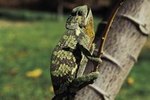
Like any exotic animal, a pet iguana requires specialized care. Iguanas in captivity regularly grow to six feet in length and weigh close to 20 pounds. The average life expectancy in captivity is around 10 years, although well-cared for iguanas may live for 20 or more years. Before getting an iguana, ask yourself if you can make a long-term commitment to a large reptile.
Habitat
Iguanas are semi-arboreal, meaning that they require both floor space and something to climb. The Green Iguana Society recommends that an iguana’s enclosure be at least twice the length of his body and a minimum of six feet tall. You may house a baby iguana in an aquarium or other small enclosure, but you will need a full-size enclosure within a couple of years. Never house two iguanas together, particularly if they are of different ages and sizes.
Heat and Humidity
Iguanas, like all reptiles, depend on external heat sources to regulate their body temperatures. The Green Iguana Society recommends a basking spot in direct sunlight or artificial sunlight that is kept at 90-95 F, and an ambient cage temperature of 80 F. Iguanas require clear day and night cycles, so the cage must be darkened at night. Iguanas require a constant humidity level of 60-75 percent. Install a thermometer and hygrometer in the cage but away from direct contact with the iguana.
Diet
Iguanas are herbivores and require a great deal of variety in their diets. You must learn about the nutrition provided by a wide range of plants to make sure that your iguana’s diet is properly balanced. Iguanas need a calcium to phosphorous ratio of two to one. Regularly choose foods from six different categories—greens, other vegetables, fruits, grains, supplemental proteins and treats. Remember that some plants are toxic to iguanas, and never feed them animal proteins. Some iguana owners provide vitamin supplements, while others feel that a balanced diet includes all the needed vitamins. Iguanas must be fed daily, and will naturally stop eating when they are full. Constant access to a fresh water bowl is required, and some owners spray their iguanas’ food with water to encourage drinking.
Handling and Taming
Start handling your iguana when he is a baby. Daily handling is the best way to tame an iguana and encourage him to trust you. Yet too much handling, particularly in the early days, stresses the iguana and encourages distrust. Allow the iguana to adapt to his new surroundings for a few days before handling him at all.
When you are ready to begin handling your iguana, move slowly and gently and allow him to get comfortable in your hands before lifting him. In an iguana-proof room, allow the iguana to explore you, gradually becoming more comfortable. Begin with one morning or evening session per day, slowly adding more sessions as the iguana shows trust. Over time, most iguanas become friendly and trusting, actively seeking out their owners’ company. Some owners are even able to litter box train and leash train their iguanas. Like any other pet, iguanas respond well to positive reinforcement and slow but persistent training methods.
References
Photo Credits
-
Jupiterimages/Photos.com/Getty Images
Writer Bio
Lisa Fritscher is a freelance writer specializing in disabled adventure travel. She spent 15 years working for Central Florida theme parks and frequently travels with her disabled father. Fritscher's work can be found in both print and online mediums, including VisualTravelTours.com. She holds a Bachelor of Arts in psychology from the University of South Florida.




